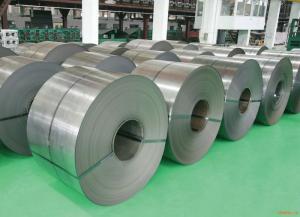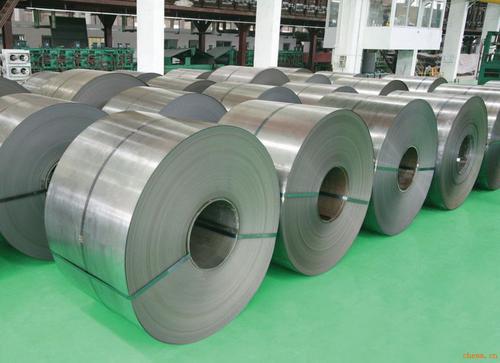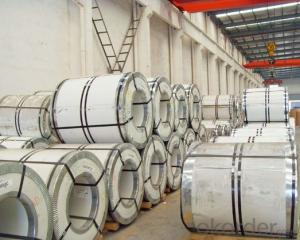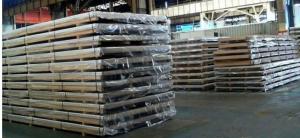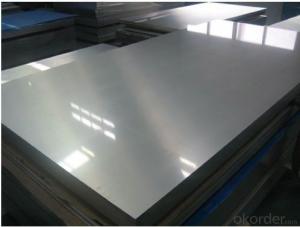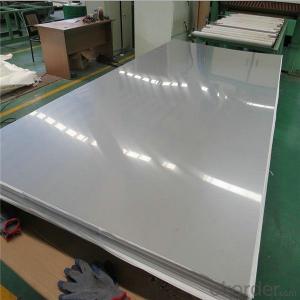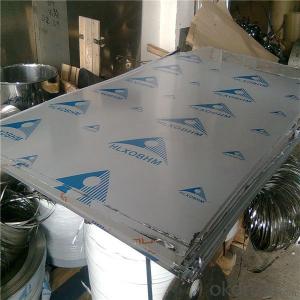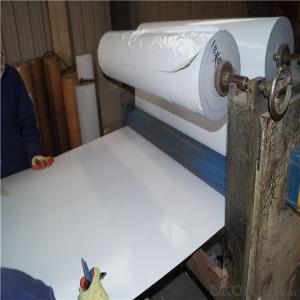STAINLESS STEEL PLATE/SHEET 304 BA PVC ON SIDE
- Loading Port:
- Shanghai
- Payment Terms:
- TT OR LC
- Min Order Qty:
- 50 m.t.
- Supply Capability:
- 10000 m.t./month
OKorder Service Pledge
OKorder Financial Service
You Might Also Like
Stainless Steel Plate
Specification:304,BA
PVC one side
Type | 2B/BA/6K stainless steel plate/sheet 304 304L |
Size/thinckness | 0.2mm-2.0mm |
Widthness | ≤1000mm or as your request |
Length | 1000mm-3000mm or as your requirement |
Standard | ASTM, AISI,GB, JIS etc |
Material | 201,202,304,304L,310s,316L,904L,316,321,410,420,430,etc |
Application range | Foodstuff, Gas, metallurgy, biology, electron, chemical, petroleum, boiler, nuclear energy, Medical equipment, fertilizer etc |
Packaging | export standard picking or as customers' requirement |
Delivery time | about 45 days working days after receiving the deposit |
Productivity | 2000 tons/month |
Chemical composition of Some Common Designations:
| Material No. | Main elements contained: maximum percentage(%) | ||||||
| C | Mn | P | S | Si | Gr | Ni | |
| 201 | 0.1 | 8.5-10 | 0.09 | 0.03 | 0.75 | 15.0-16.0 | 0.8-1.2 |
| 202 | 0.08 | 7.0-8.0 | 0.07 | 0.01 | 0.7 | 14.5-15.5 | 4.0-4.2 |
| 304 | 0.08 | 2.00 | 0.045 | 0.03 | 0.75 | 18.0-20.0 | 8.0-10.5 |
| 304L | 0.03 | 2.00 | 0.035 | 0.03 | 1.00 | 17.0-19.0 | 8.0-11.0 |
| 309 | 0.20 | 2.00 | 0.040 | 0.03 | 1.00 | 12.0-15.0 | 22.0-24.0 |
| 309S | 0.08 | 2.00 | 0.045 | 0.03 | 1.00 | 12.0-15.0 | 22.0-24.0 |
| 310 | 0.15 | 2.00 | 0.20 | 0.15 | 1.00 | 23.0-26.0 | 17.0-20.0 |
| 310S | 0.08 | 2.00 | 0.035 | 0.03 | 1.00 | 19.0-22.0 | 24.0-26.0 |
| 316 | 0.08 | 2.00 | 0.045 | 0.03 | 1.00 | 16.0-18.0 | 10.0-14.0 |
| 316L | 0.03 | 2.00 | 0.045 | 0.03 | 1.00 | 16.0-18.0 | 12.0-15.0 |
- Q: Are stainless steel strips suitable for decorative trim?
- Yes, stainless steel strips are suitable for decorative trim. Stainless steel is a versatile material that offers a sleek and modern aesthetic, making it a popular choice for decorative applications. It has a polished and reflective surface, which adds a touch of sophistication and elegance to any space. Stainless steel strips are durable, corrosion-resistant, and easy to clean, making them ideal for areas that require low maintenance. They can be used in various settings such as kitchens, bathrooms, and commercial spaces to create a contemporary and stylish look. Additionally, stainless steel strips can be easily customized and fabricated into different shapes and sizes, allowing for endless design possibilities. Overall, stainless steel strips are a great choice for adding a decorative touch to any interior or exterior space.
- Q: Are stainless steel strips suitable for brewery fermentation vessels?
- Brewery fermentation vessels can be effectively constructed using stainless steel strips. The brewing industry commonly relies on stainless steel due to its exceptional resistance to corrosion, long-lasting nature, and ease of cleaning. Its ability to withstand the acidic components and chemicals found in beer, as well as high temperatures during fermentation, make it the ideal material. The smooth and non-reactive surface provided by stainless steel strips is highly sought after for the inner walls of fermentation vessels, as it allows yeast to ferment the beer without any hindrance. Moreover, stainless steel is a hygienic material that does not introduce any unwanted flavors or aromas to the beer, ensuring the purity and excellence of the final product. In conclusion, stainless steel strips are the preferred choice for brewery fermentation vessels, as they are well-suited for the brewing process and maintain the beer's integrity.
- Q: Are stainless steel strips suitable for architectural facades?
- Architectural facades can indeed benefit from the use of stainless steel strips. This material boasts exceptional durability and resistance to corrosion, making it a perfect fit for outdoor applications. Its strength-to-weight ratio is also impressive, opening up a world of design possibilities. Architects can easily shape and size stainless steel strips to their liking, resulting in one-of-a-kind and visually striking facade designs. Moreover, when combined with other architectural elements, stainless steel's reflective surface can enhance a building's aesthetics. Another advantage is that stainless steel requires minimal maintenance, ultimately reducing cleaning and upkeep costs and ensuring long-lasting durability. In conclusion, stainless steel strips are a versatile and dependable choice for architectural facades.
- Q: Are stainless steel strips resistant to erosion?
- Yes, stainless steel strips are highly resistant to erosion. Stainless steel is an alloy composed of iron, chromium, and other elements that provide excellent corrosion resistance properties. The chromium content in stainless steel forms a protective passive layer on its surface, preventing the metal from reacting with the surrounding environment. Consequently, stainless steel strips are highly resistant to erosion caused by chemical reactions, moisture, and exposure to various atmospheric conditions. This makes them suitable for various applications where erosion resistance is crucial, such as in marine environments, chemical processing plants, and outdoor structures exposed to harsh weather conditions.
- Q: How does the price of stainless steel strips vary?
- The price of stainless steel strips can vary based on factors such as the grade of stainless steel, market demand and supply, production costs, and global economic conditions. Higher-grade stainless steel strips tend to have a higher price due to their superior quality and corrosion resistance. Additionally, fluctuations in raw material prices, such as nickel and chromium, can impact the overall cost of stainless steel strips. Market dynamics and competition also play a role in determining the pricing of stainless steel strips, with supply and demand imbalances affecting the prices.
- Q: What is the corrosion resistance of stainless steel strips?
- One notable characteristic of stainless steel strips is their excellent resistance to corrosion. This quality can be attributed to the presence of chromium in the steel, which forms a protective oxide layer on the material's surface. This layer acts as a barrier, effectively preventing oxygen and moisture from reaching the underlying steel and causing corrosion. It is worth noting that the corrosion resistance of stainless steel strips can vary depending on the specific grade and composition of the steel. In general, however, stainless steel strips are resistant to corrosion from various sources, including atmospheric conditions, water, chemicals, and high temperatures. In addition to chromium, stainless steel strips may also contain other alloying elements like nickel, molybdenum, and titanium. These elements further enhance the corrosion resistance properties of the strips. They contribute to the formation of a stable and protective oxide layer, which makes stainless steel strips highly resistant to rust, tarnish, and corrosion. Moreover, stainless steel strips can undergo passivation, a process that further improves their corrosion resistance. This process involves treating the surface of the strips with acid solutions or other chemicals to eliminate any contaminants and enhance the formation of the protective oxide layer. In conclusion, the corrosion resistance of stainless steel strips is a significant advantage, making them a popular choice in applications where durability and resistance to corrosion are crucial. This includes industries such as automotive, construction, and manufacturing.
- Q: Can stainless steel strips be used in food processing applications?
- Yes, stainless steel strips can be used in food processing applications. Stainless steel is highly resistant to corrosion, easy to clean, and does not react with food, making it a suitable material for various food processing equipment such as conveyors, mixers, and slicing machines.
- Q: Can stainless steel strips be used for solar panel frames?
- Solar panel frames can indeed utilize stainless steel strips. The use of stainless steel is renowned due to its remarkable resistance to corrosion and its durable nature, rendering it an ideal substance for outdoor purposes like solar panels. By employing stainless steel frames, the solar panels are provided with structural reinforcement, guaranteeing their stability and security. Moreover, stainless steel possesses a lightweight quality, facilitating the effortless installation and transportation of the panels. Its capability to endure severe weather conditions, encompassing rain, snow, and UV radiation, establishes stainless steel as a dependable selection for solar panel frames.
- Q: Are stainless steel strips suitable for architectural roof cladding?
- Yes, stainless steel strips are suitable for architectural roof cladding. Stainless steel is highly durable, corrosion-resistant, and has a sleek appearance, making it an ideal material for exterior applications such as roof cladding. It provides long-lasting performance, requires minimal maintenance, and can withstand harsh weather conditions. Additionally, stainless steel offers design flexibility with various finishes and textures, allowing architects to create visually appealing and modern roof designs.
- Q: What are the factors that affect the corrosion resistance of stainless steel strips?
- The factors that affect the corrosion resistance of stainless steel strips include the composition of the stainless steel alloy, the presence of impurities or contaminants, the surface finish and condition of the strips, exposure to corrosive environments such as moisture, acids, or saltwater, and the temperature at which the stainless steel is used. Additionally, factors such as mechanical stress, pH levels, and the presence of other metals or materials in contact with the stainless steel can also impact its corrosion resistance.
Send your message to us
STAINLESS STEEL PLATE/SHEET 304 BA PVC ON SIDE
- Loading Port:
- Shanghai
- Payment Terms:
- TT OR LC
- Min Order Qty:
- 50 m.t.
- Supply Capability:
- 10000 m.t./month
OKorder Service Pledge
OKorder Financial Service
Similar products
Hot products
Hot Searches
Related keywords
